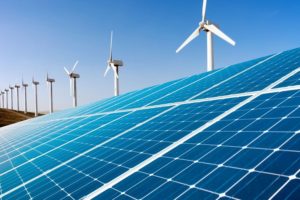Kategori : NATURAL GAS ENERGY NEWS, ELECTRICITY ENERGY NEWS, ENERGY AGENDA NEWS - Tarih : 16 May 2019
Winds of change continue to blow across the global energy landscape as firms, the general public, and policymakers shift strategic directions to address goals of environmental sustainability that also recognize economic priorities. In Germany, winters are often wet and windy when the Westerlies blow. That’s good for renewables. Germany just had a full week of 65% renewable power, following another record year of 40% renewable power in 2018. On 3 March 2019, a windy Sunday, around 90% of all power consumption was covered by renewables supply.
The German power system is balanced by fossil power and significant export potential (on the order of 15% of peak demand). Still, the national grid is transmission-capacity constrained—when the wind  turbines operate at full capacity in the north (around 50 GW), there is insufficient capacity to transport the excess to the south. Grid expansion is therefore a German priority, but progress has been slow.
turbines operate at full capacity in the north (around 50 GW), there is insufficient capacity to transport the excess to the south. Grid expansion is therefore a German priority, but progress has been slow.
German renewable power generation is dominated by solar PV and wind, both of which are variable, non-dispatchable resources. Given the policy objective to achieve 65% renewable power share by 2030, a pressing question is how to manage surpluses and deficits in an economically and environmentally meaningful way. This is not only an issue for Germany; many countries/regions around the globe face similar challenges as they adjust to the energy transition.
Flexibility
A number of options exist to balance demand and supply. More power can be traded between regions, but these options can be limited in countries such as Germany where weather patterns among neighboring countries are similar. A second option is storage. Pumped hydro potential in Germany is limited, but pumped storage is being expanded in Austria and Switzerland. The significant hydro potential in Nordic countries offer considerable load management opportunity, and more transmission lines are being put in place. Battery use is on the rise, but still very limited—less than 1 GW in a 75 GW peak demand/85 GW peak generation power system. Enter “power-to-X”.
Power-to-X (also known as “power-to-gas,” “power-to-chemicals,” and “electrons-to-molecules”) uses electricity to produce hydrogen, synthetic methane, or liquid fuels such as ammonia or methanol. Althoughpower-to-X is not new, its stature has grown in recent years, and it presents distinct possibilities to store excess renewable power generated in times of relatively low demand which can improve the economic value of renewable generation by facilitating a classic storage arbitrage. Moreover, as renewable deployment continues to expand, power-to-X also has potential to help decarbonize other sectors of the economy, such as industry and transport, that have long vexed carbon mitigation specialists.No major technology breakthroughs have occurred in the power-to-X arena in recent years, although the potential to have large quantities of low-carbon surplus electricity has sparked intense interest in this concept.
Power-to-X for hydrogen production creates some interesting opportunities. When hydrogen is produced close to power generation sources, it avoids electricity grid capacity constraints. In addition, hydrogen can be blended in relatively low concentrations (20%) with natural gas and transported in existing infrastructure with only modest operational changes; in some situations, hydrogen can be blended at much high percentages. Power-to-X for synthetic methane allows the use of existing natural gas distribution and storage infrastructure, as the gas can be stored in natural gas pipeline systems or underground for long periods of time, which can address seasonal variability constraints. Finally, power-to-X for the production of gaseous or liquid energy carriers facilitates sector coupling. For example, it can help in sector coupling in cases where electricity is not applicable or convenient, such as in aviation, iron and steel making, or chemical and petrochemical feedstocks.
Today’s technologies and the German Experience
In Germany today, there are reportedly more than 50 power-to-X projects with a capacity of 55 MW in various phases of development from planning to operating, with 26 MW of installed electrical capacity representing a more than doubling since 2014. Power-to-X, as the name implies, can lead to the development of a variety of fuels, energy carriers, and energy services. Today, natural gas often serves as one of the main feedstocks for the production of hydrogen, ammonia and other fuels. In the future, cleaner versions of these products may depend on using hydrogen that is produced in novel ways, but both challenges and opportunities must be weighed in order to understand where work is needed.





